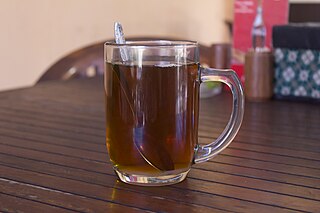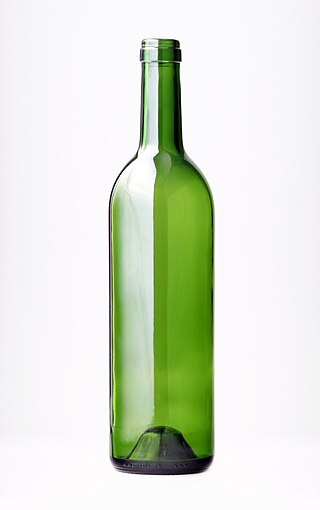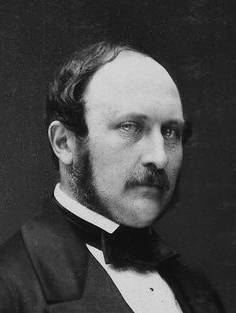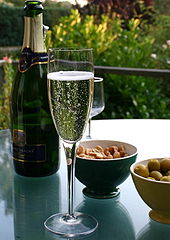
A drink or beverage is a liquid intended for human consumption. In addition to their basic function of satisfying thirst, drinks play important roles in human culture. Common types of drinks include plain drinking water, milk, juice, smoothies and soft drinks. Traditionally warm beverages include coffee, tea, and hot chocolate. Caffeinated drinks that contain the stimulant caffeine have a long history.

Champagne is a sparkling wine originated and produced in the Champagne wine region of France under the rules of the appellation, which demand specific vineyard practices, sourcing of grapes exclusively from designated places within it, specific grape-pressing methods and secondary fermentation of the wine in the bottle to cause carbonation.

A bottle is a narrow-necked container made of an impermeable material in various shapes and sizes that stores and transports liquids. Its mouth, at the bottling line, can be sealed with an internal stopper, an external bottle cap, a closure, or induction sealing.

Carbonated water is water containing dissolved carbon dioxide gas, either artificially injected under pressure, or occurring due to natural geological processes. Carbonation causes small bubbles to form, giving the water an effervescent quality. Common forms include sparkling natural mineral water, club soda, and commercially produced sparkling water.

A cocktail glass is a stemmed glass with an inverted cone bowl, mainly used to serve straight-up cocktails. The term cocktail glass is often used interchangeably with martini glass, despite their differing slightly. Today, the glass is used to serve a variety of cocktails, such as the martini and its variations, Manhattan, Brandy Alexander, pisco sour, Negroni, cosmopolitan, gimlet, and the grasshopper.

White wine is a wine that is fermented without undergoing the process of maceration, which involves prolonged contact between the juice with the grape skins, seeds, and pulp. The colour can be straw-yellow, yellow-green, or yellow-gold. It is produced by the alcoholic fermentation of the non-coloured pulp of grapes, which may have a skin of any colour. White wine has existed for at least 4,000 years.

A snifter is a type of stemware, a short-stemmed glass whose vessel has a wide bottom and a relatively narrow top. It is mostly used to serve aged brown liquors such as bourbon, brandy, and whisky.

Stemware is drinkware where the bowl stands on a stem above a foot. It is usually made from glass, but may be made from ceramics or metals. The stemware is intended for cool beverages, like water or wine. The stem allows the drinker to hold the glass without affecting the temperature of the drink. The snifters represent an exception, as they are designed to hold the bowl in a cup of the hand to warm up the beverage.

Beer is a major part of German culture. According the Reinheitsgebot, only water, hops, yeast and malt are permitted as ingredients in its production. Beers not exclusively using barley-malt, such as wheat beer, must be top-fermented.
Wine accessories are things that may be used in the storage or serving of wine. Wine accessories include many items such as wine glasses, corkscrews, and wine racks.

A black velvet is a beer cocktail made from a combination of stout and white sparkling wine.

A wine glass is a type of glass that is used for drinking or tasting wine. Most wine glasses are stemware (goblets), composed of three parts: the bowl, stem, and foot. There are a wide variety of slightly different shapes and sizes, some considered especially suitable for particular types of wine.

Beer glassware comprise vessels, today usually made of glass, designed or commonly used for serving and drinking beer. Styles of beer glasses vary in accord with national or regional traditions; legal or customary requirements regarding serving measures and fill lines; such practicalities as breakage avoidance in washing, stacking or storage; commercial promotion by breweries; artistic or cultural expression in folk art or as novelty items or usage in drinking games; or to complement, to enhance, or to otherwise affect a particular type of beer's temperature, appearance and aroma, as in the case of its head. Drinking vessels intended for beer are made from a variety of materials other than glass, including pottery, pewter, and wood.
The glossary of wine terms lists the definitions of many general terms used within the wine industry. For terms specific to viticulture, winemaking, grape varieties, and wine tasting, see the topic specific list in the "See also" section below.
Absinthiana is the paraphernalia surrounding the consumption of absinthe. Due to the bitter taste and high alcohol content of this drink, a need for dilution with water had led drinkers to a drinking ritual. Originally, absinthe was served in standard stemmed wine or water glasses and water was added from a simple carafe. But as its popularity grew so did the variety of implements used, such as specialty glasses and complex brouilleurs. Many 19th century companies used the elaborate barware to advertise their brands. Today, many contemporary distilleries are also producing decorative branded barware for the same purpose.

Wine tasting is the sensory examination and evaluation of wine. While the practice of wine tasting is as ancient as its production, a more formalized methodology has slowly become established from the 14th century onward. Modern, professional wine tasters use a constantly evolving specialized terminology which is used to describe the range of perceived flavors, aromas and general characteristics of a wine. More informal, recreational tasting may use similar terminology, usually involving a much less analytical process for a more general, personal appreciation.

A mimosa cocktail consists of champagne and chilled citrus juice, usually orange juice. It is often served in a tall champagne flute at festive occasions such as brunch, weddings, or as part of business or first class service on some passenger railways and airlines. The mixing ratio varies.

The Airmail or Air Mail is a classic cocktail based on rum, lime or lemon juice, honey, and sparkling wine. It was probably created during or shortly after the period of prohibition in the United States of America or on Cuba, i.e. in the 1920s or 1930s.

A Nick & Nora glass is a stemmed glass with an inverted bowl, mainly used to serve straight-up cocktails. The glass is similar to a cocktail glass or martini glass.


















